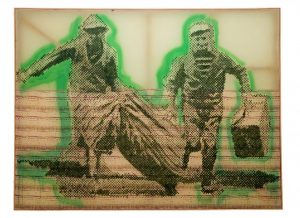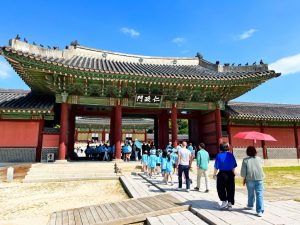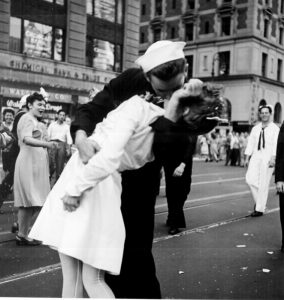Visually dense and conceptually expansive, “Space Makers: Indigenous Expression and a New American Art” surveys multiple movements and styles often absent from museums of American art. The exhibition foregrounds flat, organic abstraction from midcentury New York known as Indian Space Painting amid a mix of graphic works by Native American artists from the 1960s to the present, as well as 19th-century Indigenous objects from multiple regions around the country. Interpretive text emphasizes “shared visual forms” among nearly three dozen works across two galleries, while motifs echo through distinct media and time periods.
Related Articles
Groupings of objects frequently combine examples of historic Native art, New York paintings, and contemporary Native art. One grouping revolves around a 19th-century naaxein, or Chilkat robe, with columns of trapezoids and ovals that contain multitudes: eyes, nested shapes, faces, profiles of bird heads, and a bold black line that unifies the atomized composition. An undulating mount animates the textile as if it were being danced, evoking its origins and intended use in a Tlingit community in Southeast Alaska. To the right of the robe hangs a 1944 oil painting Untitled (Don Quixote) by Robert Barrell, an artist active in New York. At left is Nathan Jackson’s 1963 woodblock print Kooshta, from his student years at the Institute of American Indian Arts (IAIA) in Santa Fe. Jackson and Barrell each isolate and reposition elements of historic Northwest Coast design of the kind seen in the robe. Here, the naaxein appears as a vital source of inspiration for diverse artists working decades later in far-flung contexts.
A 19th century naaxein, or Chilkat robe, on view in the exhibition “Space Makers: Indigenous Expression and a New American Art” at the Crystal Bridges Museum of American Art in Bentonville, Ark.
Photo Tom McFetridge
In the late 1930s, artists such as Barrell, Steve Wheeler, and Peter Busa began to blend Picasso’s Cubist vision with Indigenous design principles, especially those from the Northwest Coast and Peru. These artists sought to make flat paintings without regard for figure or ground, pushing Picasso’s deconstructed pictorial space to a logical conclusion. In Untitled (Don Quixote), shown with the robe mentioned above, Barrell uses an energetic, sinuous line to unite an overwhelming assortment of shapes and elements from Native art, including animal profiles from the Northwest Coast, fragments of Diné (Navajo) woven textiles, and ancient open-palm plaques from the Ohio River Valley.
Barrell and the others inspired a wider movement that came to be known as Indian Space Painting, in which a shared interest in flat pictorial space and Native art coalesced in a 1946 exhibition at Gallery Neuf in New York that also included Gertrude Barrer, Howard Daum, and Ruth Lewin. At the same time, a number of these artists launched Iconograph magazine, articulating a diffuse interest among New York painters in Native American art. The show includes a digital copy of the first issue.
In addition to the recognized Indian Space Painters, “Space Makers” includes more famous New York artists who also pursued abstraction in the 1930s and ’40s. Paintings by Stuart Davis and Jackson Pollock flank a panel of text describing the Art Students League of New York, a leading art school that helped shape multiple movements in modern art. Davis taught at the League in the 1930s, and his students included Busa and Pollock, the latter here represented by a pre-drip canvas. Also included in “Space Makers” is a 1953 painting on paper by George Morrison, an Anishinaabe artist from Minnesota who moved to New York in the 1940s, studied at the League, and largely disavowed critical efforts to identify Indigenous themes in his East Coast abstractions.

Peter Busa: Children’s Hour, ca. 1948.
Charles and Valerie Diker Collection
We might expect to see 1940s-era New York painters juxtaposed with historic Native art, since New York artists enjoyed multiple opportunities to view Indigenous art, including the 1941 show “Indian Art of the United States” at the Museum of Modern Art. But while Pollock is often recognized as lifting his drip process from Diné sandpainting, little attention has been paid to an earlier, pervasive interest in Native art among New York painters.
In that way, “Space Makers” helps redefine elements of modern American art, expanding the story of abstraction beyond a persistent focus on expressionist technique. And curator Christopher T. Green advances a step further by including more recent work by Indigenous artists in an exhibition that destabilizes a New York–centric story. Equally critical for “Space Makers” is graphic work associated with the Institute of American Indian Arts. Founded in 1962, the Institute revolutionized pedagogy in Native American art by emphasizing direct experimentation with a wide range of materials and the study of global art history. This contrasted with earlier approaches through which Native art students considered only historic Native art and their lived experience as source material, and professional artistic production was tightly regulated through a series of juried competitions.
A satellite room in “Space Makers” presents digitally interactive materials including a relational map of the artists and themes. Nodes include IAIA, Indian Space Painters, Indigenous Visual Design, and the Art Students League of New York. Individual artists or styles branch out from nodes. A single artist, Seymour Tubis, occupies the center and connects to each node. Tubis studied at the League in the early 1940s, where he “drew upon the Indian Space Painter’s concepts” and then taught at IAIA starting in the 1960s, “impart[ing] the movement’s abstracting design principles.” While his artwork does not feature in the show—a notable omission—Tubis emerges as a pivotal figure in the narrative. For decades, many observers have described IAIA as the birthplace of contemporary Native art. “Space Makers” hints at a longer trajectory: Indian Space Painting too may be seen as a point of origin for contemporary Native art.
The Indian Space Painters sought to break through models of pictorial space rooted in figure/ground distinctions, and one institution, IAIA, radically changed the practice of Native studio art. Each movement relied on deep engagement with the formal aspects of historic Native art, and by focusing on both, “Space Makers” identifies a loose set of entangled histories that offer a promising method for relational art history.
But for curators and scholars today, the challenge is to tell stories that move beyond categorical thinking and disregard strong definitions—received or expanded—of Native American or American art. Per the wall text and the show’s subtitle (“Indigenous Expression and a New American Art”), however, “Space Makers” ultimately recasts narratives of American art rather than Native American art. In a fully relational and flat history, Native artists and objects would command the focus of analysis as much as their non-Native counterparts.




